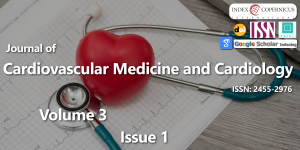Tetrahydrobiopterin Concentrations in Normal and Coronary Artery Diseased Heart Tissue
Main Article Content
Abstract
Background: Tetrahydrobiopterin (BH4) is a cofactor that plays a major role in cardiovascular health and disease. BH4 levels in the human heart have not been previously reported.
Objective and Methods: Using a novel LC-MS/MS method we measured BH4 and BH2 levels in human heart tissue from subjects with (n=19) and without (n=19) coronary artery disease (CAD).
Results: The concentration of BH4 was significantly lower in CAD subjects compared to controls (p=0.0006). There was a trend for a decrease in BH4/BH2 ratio (p=0.09). mRNA expression of GCH1, NOS3 and <emqdpr< em="">was not significantly different between CAD and controls.</emqdpr<>
Conclusions: We conclude that the decrease in BH4 concentration in the left ventricular wall of subjects with CAD may be a causative factor or consequence of the failing heart.
Downloads
Article Details
Copyright (c) 2016 Arning E, et al.

This work is licensed under a Creative Commons Attribution 4.0 International License.
Katusic ZS, d'Uscio LV, Nath KA (2009) Vascular protection by tetrahydrobiopterin: progress and therapeutic prospects. Trends Pharmacol Sci 30: 48-54 .
Setoguchi S, Mohri M, Shimokawa H, Takeshita A (2001) Tetrahydrobiopterin improves endothelial dysfunction in coronary microcirculation in patients without epicardial coronary artery disease. J Am Coll Cardiol 38: 493-498 .
Cosentino F, Katusic ZS (1995) Tetrahydrobiopterin and dysfunction of endothelial nitric oxide synthase in coronary arteries. Circulation 91: 139-144 .
Vasquez-Vivar J (2009) Tetrahydrobiopterin, superoxide, and vascular dysfunction. Free Radic Biol Med 47: 1108-1119 .
Shirodaria C, Antoniades C, Lee J, Jackson CE, Robson MD, et al. (2007) Global improvement of vascular function and redox state with low-dose folic acid: implications for folate therapy in patients with coronary artery disease. Circulation 115: 2262-2270 .
Moens AL, Ketner EA, Takimoto E, Schmidt TS, O'Neill CA, et al. (2011) Bi-modal dose-dependent cardiac response to tetrahydrobiopterin in pressure-overload induced hypertrophy and heart failure. J Mol Cell Cardiol 51: 564-569.
Tratsiakovich Y, Gonon AT, Kiss A, Yang J, Böhm F, et al. (2013) Myocardial protection by co-administration of L-arginine and tetrahydrobiopterin during ischemia and reperfusion. Int J Cardiol 169: 83-88 .
Dumitrescu C, Biondi R, Xia Y, Cardounel AJ, Druhan LJ, et al. (2007) Myocardial ischemia results in tetrahydrobiopterin (BH4) oxidation with impaired endothelial function ameliorated by BH4. Proc Natl Acad Sci U S A 104: 15081-15086 .
Bendall JK, Damy T, Ratajczak P, Loyer X, Monceau V, et al. (2004) Role of myocardial neuronal nitric oxide synthase-derived nitric oxide in beta-adrenergic hyporesponsiveness after myocardial infarction-induced heart failure in rat. Circulation 110: 2368-2375 .
Ambardekar AV, Walker JS, Walker LA, Cleveland JC Jr, Lowes BD, et al. (2011) Incomplete recovery of myocyte contractile function despite improvement of myocardial architecture with left ventricular assist device support. Circ Heart Fail 4: 425-432 .
Arning E, Bottiglieri T (2014) LC-MS/MS Analysis of Cerebrospinal Fluid Metabolites in the Pterin Biosynthetic Pathway. JIMD Rep .
Whitsett J, Rangel Filho A, Sethumadhavan S et al. (2013) Human endothelial dihydrofolate reductase low activity limits vascular tetrahydrobiopterin recycling. Free Radic Biol Med 63: 143-150 .
Bendall JK, Douglas G, McNeill E, Channon KM, Crabtree MJ (2014) Tetrahydrobiopterin in Cardiovascular Health and Disease. Antioxid Redox Signal 20: 3040-3077 .





